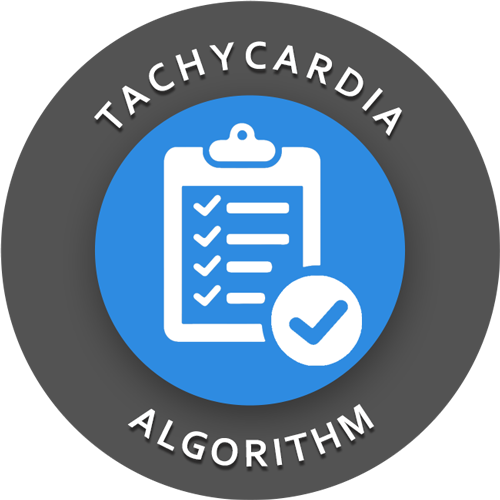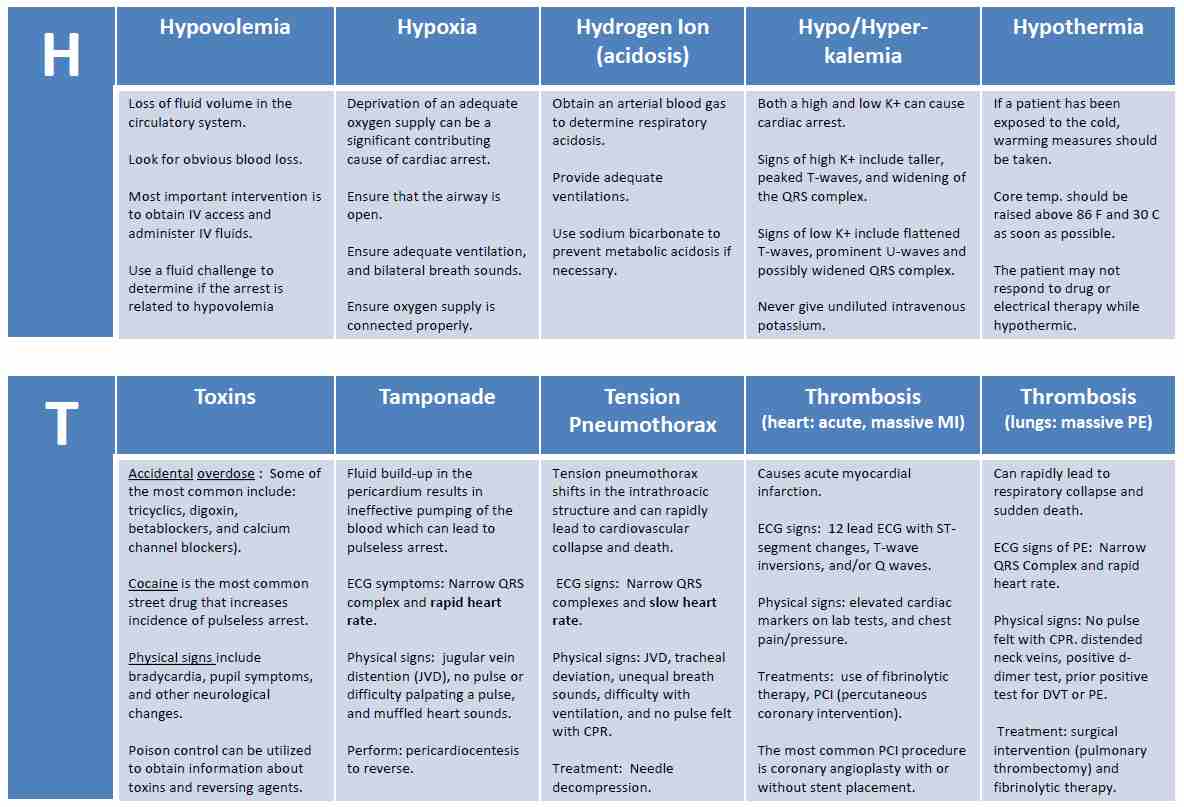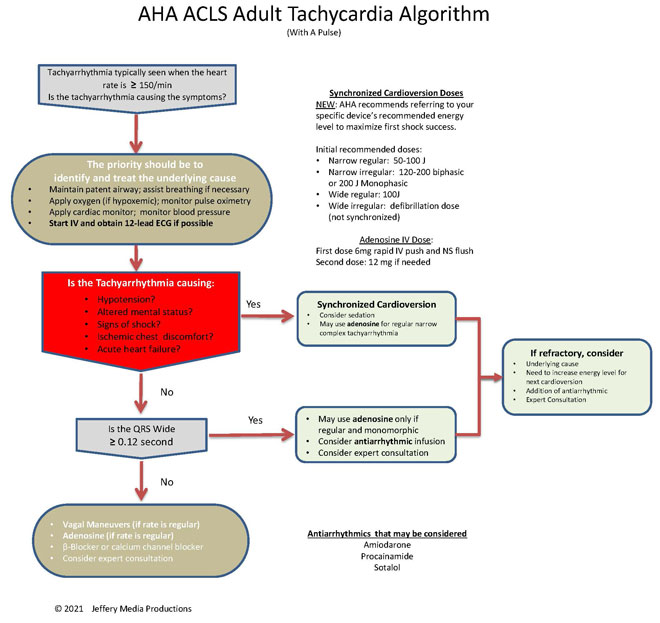 Tachycardia/tachyarrhythmia is defined as a rhythm with a heart rate greater than 100 bpm.
Tachycardia/tachyarrhythmia is defined as a rhythm with a heart rate greater than 100 bpm.
An unstable tachycardia exists when cardiac output is reduced to the point of causing serious signs and symptoms.
Serious signs and symptoms commonly seen with unstable tachycardia are: chest pain, signs of shock, SOA (short of air), altered mental status, weakness, fatigue, and syncope.
One important question you may want to ask is: “Are the symptoms being caused by the tachycardia?” If the symptoms are being caused by the tachycardia treat the tachycardia.
Causes
There are many causes of both stable and unstable tachycardia and appropriate treatment within the ACLS framework requires identification of causative factors. Before initiating invasive interventions, reversible causes should be identified and treated.
The most common causes of tachycardia that should be treated outside of the ACLS tachycardia algorithm are dehydration, hypoxia, fever, and sepsis. There may be other contributing causes and a review of the H’s and T’s of ACLS should take place as needed.
Click below to view the H and T’s table. When done click again to close the diagram.
H’s and T’s Table

Administration of OXYGEN and NORMAL SALINE are of primary importance for the treatment of causative factors of sinus tachycardia and should be considered prior to ACLS intervention.
Once these causative factors have been ruled out or treated, invasive treatment using the ACLS tachycardia algorithm should be implemented.
Associated Rhythms
There are several rhythms that are frequently associated with stable and unstable tachycardia these rhythms include:
- Supraventricular tachycardia (SVT)
- Atrial fibrillation
- Atrial flutter
- Monomorphic VT
- Polymorphic VT
- Wide-complex tachycardia of uncertain type
ACLS Treatment for Tachycardia
Click below to view the tachycardia algorithm diagram. When done click again to close the diagram.
Tachycardia Diagram

or Members Download the Hi-Resolution PDF Here(This will open in another window.)
The first question that should be asked when initiating the ACLS tachycardia algorithm is: “Is the patient stable or unstable?” The answer to this question will determine which path of the tachycardia algorithm is executed.
Unstable Tachycardia
Patients with unstable tachycardia should be treated immediately with synchronized cardioversion. If a pulseless tachycardia is present patients should be treated using the cardiac arrest algorithm.
The AHA no longer provides specific shock dose recommendations for synchronized cardioversion. Instead, they instruct to refer to your specific device’s recommended energy level to maximize first shock success.
For the purposes of a basic understanding of cardioversion, the information about general shock dosages and recommendations will remain in the content on this website.
The initial recommended synchronized cardioversion voltage doses are as follows:
- narrow regular: 50-100 J; i.e., SVT and atrial flutter
- Narrow irregular: 120-200 J biphasic or 200 J monophasic; i.e., atrial fibrillation
- Wide regular: 100 J; i.e., monomorphic VT
- Wide irregular: defibrillation dose (not synchronized)
Stable Tachycardia
Patients with stable tachycardia are treated based upon whether they have a narrow or wide QRS complex. The following flow diagram shows the treatment regimen for stable tachycardia with narrow and wide QRS complex.
- Stable (narrow QRS complex) → vagal maneuvers → adenosine (if regular) → beta-blocker/calcium channel blocker → get an expert
- Stable (wide/regular/monomorphic) → adenosine → consider antiarrhythmic infusion → get an expert
Rudy Ares says
Excelent website.
It’s amazing what I have learned today
Thank you.
zeekman says
Can you please confirm the syncronized cardioversion doses in the above algorithm? I am confused as to which rhythms go in each category. I was reading on the AFlutter page that it is a lower dose 20-50J I think it said…. Do I have these right?
Narrow Regular 50-100 – SVT
Narrow Irregular 120-200 – Afib, Aflutter
Wide Regular 100 – VTach
Wide Irregular Defibrilation -Torsades
Are there others I am missing?
Jeff with admin. says
For Cardioversion here is what you should remember for dosing sequences:
(narrow complex regular) 50-100-200-300-360 (a-flutter is usually has a regular rate. The starting shock dose can be 20-50J)
(narrow irregular) 120-200-300-360
(wide complex regular) 100-200-300-360
(wide irregular) defibrillation same as VT/VF
Kind regards, Jeff
aclsstudy says
Your site is excellent help!
I you please simplify unstable and stable Tachycardia and shocks in joules given.
How can it be analyzed quickly and acted upon.
Thanks, you are great help.
Jeff with admin. says
The easiest way to simplify the stable and unstable tachycardia is through a diagram shown in the article above. If you click on the text link labeled “Tachycardia Algorithm Diagram” this should be helpful. Hopefully, this diagram makes the tachycardia algorithm a little easier to understand.
I have also tried to make the algorithm as easy as possible to understand through this web page above. I’m not sure if it can be simplified much further. The tachycardia algorithm is probably the most complex algorithm. This is why expert consultation should be considered if the pt. is not to unstable.
Kind regards,
Jeff
Vivienne says
While resuscitating a patient , do you give the patient iv fluids or do you wait until the patient is post arrest before giving I’ve fluids
Jeff with admin. says
IV fluids may be started during resuscitation if it does not delay the basic ACLS interventions that should be taking place. If there is a person designated specifically for giving IV medications, they can start IV fluids while waiting to give the next dose of epinephrine. Fluids can play a vital role in several types of cardiac arrest.
Post resuscitation IV fluids can also play a major role in the patient recovery after ROSC.
Kind regards,
Jeff
Vivienne says
Hello..been your comments and it really is very informative. In a patient that supraventricular tachycardia, Would you consider a patient unstable if the bp down to palpatory 80 from 100/60 with good o2sats even after giving the patient adenosine 6 mg? In short should I manage the patient as stable and give subsequent dose of amiodarone 12 mg or just do cardioviorsion.?
Would really appreciate you reply, thanks…
Jeff with admin. says
This blood pressure is not to good. However, I have seen patients stable with a SBP of 80. I would say that you should also look at other signs/symptoms. LOC, chest pain, signs of poor perfusion, short of breath, mottled skin.
A patient is unstable if they display signs of poor perfusion. Blood pressure is just one indicator. If the patient is unstable, you will have other indicators.
I would be ready to use synchronized cardioversion on this patient, but I would say you would be ok to give the 2nd dose of adenosine.
Kind regards,
Jeff
AnitaC says
LOVE THIS SITE!!!
IT IS THE BEST, MAKES IT EASIER
Ronny Gooriah says
Hi Jeff with Admin.
This is a great site with very necessary information.
I wanted to ask you, what if a patient with SVT is presented and is Stable, Vagal maneuvres done but Adenosine is not available in the hospital, and Iv Verapamil is to be used.
What will be the correct algorithm after Failed Vagal maneuvre in a stable patient.
I wanted to know about the Verapamil dosage and amount of times it can be repeated and next.
Thank you.
Chris with admin. says
This is beyond the scope of ACLS, and the subject is more complex than can be discussed in a few short lines, but if the patient has a narrow complex tachycardia with no evidence of Wolff-Parkinson-White syndrome then the following dosages of verapamil can be used:
2.5-5 mg IV over 2 minutes; 5-10 mg dose may be repeated after 15-30 minutes
Alternatively, 0.075-0.15 mg/kg (not to exceed 10 mg) IV over 2 minutes; dose may be repeated once 30 minutes after first dose
There are other drugs that can be used by this comes down to physician preference.
Kind regards,
Chris
Ronny D. Gooriah says
Thank you Chris, after so long:)
MCKINNEY says
I WILL GO BACK OVER THIS BUT I THINK MY LIGHT BULB JUST CAME ON. IT’S NOT TOTALLY BRIGHT BUT IT WILL ONCE I UNDERSTAND . THX
Hristina Petkova says
Hello, may be you have already discussed that before, but I am interested in how many joules you would use for delivering a sync cardioversion in case of unstable patient in VT with pulse?
Thanks!
Hristina
Jeff with admin. says
The AHA recommends the following sequence:
100 J–then–200 J–then–300 J–then–360 J
(this information is from the AHA ACLS advanced provider manual pg. 133)
Kind regards,
Jeff
gerdesmond says
If a person has a pre-existing LBBB how would you approach management eg. if they came in with a fever and a wide-complex tachycardia could this be simply their version of a sinus tachy ?
Jeff with admin. says
It could be their version of sinus tachycardia. The rate will most likely be less than 150 and they will most likely be asymptomatic. However, if they have any symptoms such as chest pain, shortness of air, hypotension the you would work the pt. up to rule out cardiac problems.
Also, obtain a good history and treat the fever.
Kind regards,
Jeff
gerdesmond says
If you are trying to cardiovert VT(presumed monomorphic) how long should you give the machine to sync before switching to defib mode ?
Jeff with admin. says
If the patient is unstable and the defibrillator will not SYNC, the machine should indicate “failed to capture or failed to SYNC.” If you get failure capture in an unstable patient then you should immediately switch to unsynchronized and shock the patient.
Kind regards,
Jeff
zaaba PRABA says
It should be SOB NOT SOA right ?
Jeff with admin. says
Either on. SOA means “short of air” and SOB means “short of breath.” SOB also has other meanings and this is why I use SOA.
Kind regards,
Jeff
Vicki Buzzi says
hi so Rvt, or Rvf you would shock then give an anti arythmic ? I feel like I understand then I become confused! hmmm is this normal. thanks for your help Vicki buz
Jeff with admin. says
Defibrillation (unsynchronized cardioversion) will be used PULSELESS VT and VF. True VF will always be pulseless. The following is always the sequence for VT and VF assuming that the defibrillator is attached: Shock, CPR, rhythm check, shock, CPR/epinephrine, rhythm check, shock, CPR/amiodarone, rhythm check….
Stable or unstable tachycardia with a pulse is handled in an number of different ways. Download the tachycardia algorithm diagram and take a look. The main intervention for any unstable tachycardia should be synchronized cardioversion.
Kind regards,
Jeff
Kathy Walden says
Thank you Jeff! Your website rocks. I passed ACLS just using your site as a study guide. Now I use it to update my knowledge and skills weekly. Thanks again….God Bless:)
ucerpac says
Hi Jeff with admin
Im getting confused on the diagnosing of Tachycardia, unstable pt, wide QRS. Is the VF/VT algorithym used, or the Tachycardia algorithym used. Im thinking it centers around wether you can determine if there is a “P” wave in the EKG, correct? ie a Supraventricular tachycardia by definition has a “P” wave thus means you use the Tachycardia algorithym and non “P” wave means its the ugly VT thus gets treated with the VF/VT algorithym. Correct?
Jeff with admin. says
If a patient is pulseless you will use the pulseless arrest algorithm. If the patient has VF or VT and is pulseless use the left branch of the pulseless arrest algorithm. Any other rhythm that is pulseless, you will use the right branch of the pulseless arrest algorithm.
If you have a pulse, then you will determine which algorithm to use based upon the rate of the pulse (bradycardia or tachycardia). If bradycardia use the bradycardia algorithm. If tachycardia use the tachycardia algorithm.
Kind regards, Jeff